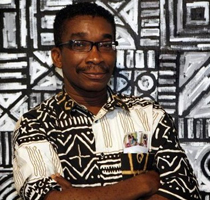From the above, you ask, why would anybody now want to imperiously force any globalized identity debate-cloak on Anatsui? Anatsui himself is very unequivocal in enunciating his views when it comes to staying in Africa as against relocating to a Western metropolis, and the African environ and history being the stimuli for his work. He has always been very proud of his origin “born 1944 in Anyako, Ghana…†unlike many other successful African artists living in the West, who do not even now want to be associated with Africa at all. Chris Ofili is a typical example. They prefer to be described simply as artists instead of an African artist. They find the “African†tag rather condescending and derogatory, for whatever reason, I do not know.
Chike Okeke-Agulu’s cursory comment only feeds the growing perception of a grand scheme spearheaded by the Nigerian-born international curator and writer, Okwui Enwezor, and his cohort of disciples, Okeke-Agulu included, to shift the polarity of contemporary African art practice and discourse from Africa to the West. This strategy is obnoxious and evil and would have to be challenged and condemned in no uncertain terms. The Okwui Enwezor School paints a bleak picture of Africa, as if nothing worthwhile is happening on the continent. It has developed a complex, bizarre philosophy based on the writings of V.Y Mudimbe and Paul Gilroy which suggests that Africa and African culture are imaginary concepts, a firmament of the imagination, that no common African culture exists, and that the real Africa is the African Diaspora, the Africa which has come in contact with the West. Based on this false and unfounded philosophy, all their curatorial work and writings on contemporary African art are skewed in favor of the few African artists domiciled in the West, in Europe or America, marginalizing the bulk of their counterparts who live and work on the African continent. These privileged Diaspora African artists are re-circled from one mega-show to the other, hailed far and above their colleagues in Africa and widely published in all the emerging books on contemporary African art. Even beginning artists, neophytes who are now cutting their teeth as artists, but for the obvious fact that they live in the West, have been made overnight into superstars by Okwui Enwezor and his school, whilst some African contemporary masters, who have worked a lifetime and are in the dotage of their years, have been banished into total obscurity and oblivion, all for the simple reason that they live in Africa. This curatorial protocol adopted by Enwezor and his team, which privileges the Diaspora African artist to the neglect of the home-based African artists, and is now fast being adopted by other non-African curators and writers, as well, because they see it as the status quo, is absolutely wrong and odious, and has to be resisted. The sooner Enwezor and his disciples changed from this protocol to look more closely into the mother continent, the better.
It is not with any animosity that I am interrogating Okwui Enwezor’s curatorial work. Some colleagues of mine, interestingly, all living abroad, have tried to restrain me from going ahead with my critique. Some have suggested that Enwezor has become so powerful, moving in the high corridors of art, he could easily destroy me if I dare raise a voice against him, whilst others see a criticism of Enwezor as an indirect attack on the whole establishment of contemporary African art, which, to them, has struggled so much to get to the present height it is enjoying today, therefore has to be spared of any reproach. I totally disagree with the assertion of those colleagues of mine. What they fear and are intimating are even the more reason why Enwezor’s intervention for African art has to be brought to close scrutiny and objectively criticized with perspicuity. He has become the apotheosis synonymous with contemporary African art in the West, in fact, the sole advocate, and anything he spills out there, the art world would swallow it whole-meal without any question, because it is coming from Okwui Enwezor.
I am proud I was one of the first to hail Okwui Enwezor as far back as 2003, when few people knew him on the African continent, in an international conference paper as “the non-pareil African Art Historian, Critic and Curator.†This is how I opened the chapter on Enwezor in my paper:
This paper on the State of Fine Art in Africa will not be complete without talking about one African art historian, critic and curator who has had an extraordinary career and, at the young age of 38, distinguished himself into world – class stature. He is the Nigerian born and bred Okwui Enwezor. It is important talking about Okwui, as he is popularly called here, because I know for a fact that many serious contemporary practitioners of art in Africa do not know who he is nor are they familiar with his curatorial activities or extensive writings…
We have an adage in Africa which says, literally, “One does not know his back is crooked if he is busy cutting a pathwayâ€. Okwui Enwezor is cutting a pathway for Africa. He has done so much, in fact, immeasurably in bringing international critical attention to contemporary African art, centering it within the global discourse of art and he deserves high commendation for that. But he is beginning to go crooked! And his attention has to be urgently drawn to that. As another African adage goes, “Observers are Worried.†And I am only being a voice of the worried observers, the voiceless masses.
The undue focus of Okwui Enwezor and his henchmen on African Diaspora artists, side-lining their counterparts on the continent, only smacks of a very selfish motive and utter laziness in curatorship. I hate to think so, but I cannot figure out any other plausible reason for this lop-sided curatorial bias. With Okwui’s meteoric rise to the apogee of the curatorial world, obviously, it would be expected by the mainstream art establishment for Enwezor and his team of critics, historians, writers and curators to go back home to Africa, with fairly improved political and social conditions than what impelled them to migrate to the West, to help build the necessary structures and platform for the advancement of contemporary art on the continent. But because of their continual stay in the West, and their reluctance to relocate back home, Enwezor and his disciples have had to create the erroneous impression to the art world, that there was not much happening on the continent of Africa, and that if you want authentic contemporary African art, just look to the West, to the African Diaspora, which to them, is the real Africa. This is absurd! Absolutely preposterous! So, for one man’s selfish reason in protecting a hard-earned empire he has built for himself as the Curator-Supremo of contemporary African art, and to justify his continual stay in the West, a whole continent’s art has to be marginalized and subjugated through self-satisfying, idiosyncratic strategies.
Apart from this selfish motive, coming to think of it, it really does not cost anything to continue recycling the same old names as the pantheon of heroes of contemporary African art, because of their easy visibility and accessibility – they live in the West. It is expensive, of course, to undertake frequent field research into Africa, visit all the countries on the continent to find out what is currently happening on the ground there. African contemporary art is in very dynamic and complex flux and it is simply difficult to keep pace with it. A survey book written today on contemporary African art, for instance, will be outdated in no time – three years, at most. The contemporary creative energy of the African continent is simply overwhelming and has not been documented or theorized enough. It is almost impossible to really keep abreast with it. And that is exactly what I expect Enwezor and his team to attempt to do, but they prefer the easier pathway, which I call lazy curatorship – sitting comfortably in their studies in Europe and America, and turning over the same old Western – based names, over and over again, in their representation of Africa. As I have said earlier, the current curatorial strategy of Okwui Enwezor and his school is inimical to the advancement of contemporary art on the continent and, surreptitiously, thwarts its growth. Indeed, the magnitude of its repercussion is far reaching and it may take generations of African artists yet to be born to recover from this dastardly, despicable curatorial scheme, designed to slump art on the mother continent, unless the status quo is quickly remedied.





No Comments so far ↓
There are no comments yet...Kick things off by filling out the form below.